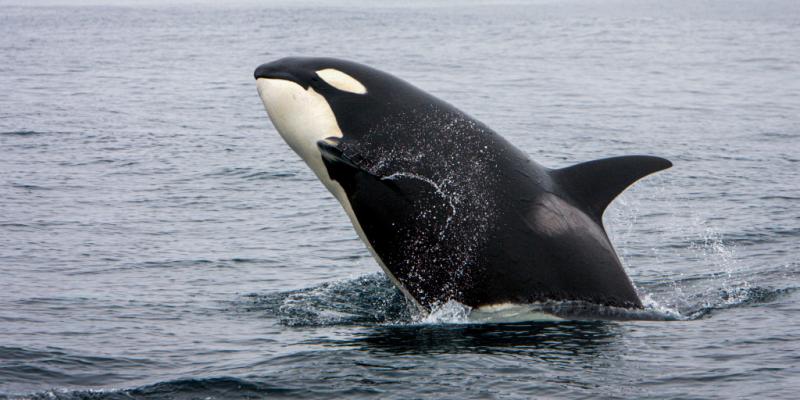Killer whale spotted balancing a salmon on its head



A killer whale was spotted balancing a salmon on its head earlier this fall near the coastline in Washington state, surprising scientists and intriguing orca watchers.
The critically endangered southern resident killer whale was photographed with a "salmon hat" in late October near Point No Point, just off the northern tip of Washington's Kitsap Peninsula, according to the Orca Network, a nonprofit focused on the species' conservation.
The whale is known to marine biologists and whale watchers as J27, though it is also called Blackberry. Groups like the Orca Network track sightings of individual whales.
Orcas were previously spotted sporting salmon on their heads in the late 1980s, said Deborah Giles, science and research director of Wild Orca, a nonprofit conservation and research group.
"It's something that seemingly popped up out of nowhere in the 80s," she said, adding that the behavior then apparently faded away for decades. It's not clear what the behavior means, she said.
Giles spends a lot of time on the water and near orcas for her research. She uses trained dogs on boats to sniff out and collect the whales' feces to analyze their health.
In early November, Giles said she saw a southern resident killer whale exhibit the salmon-on-head behavior — the second recent observation of it. She's not sure if the whale she saw was J27 or not.
"What I saw was the head of the whale and fish on the head. I didn't see the dorsal fin or saddle patch," she said, referring to the parts of the whales' bodies used for identification.
Giles added that she can recall seeing southern resident killer whales do that four or five times since 2005.
She speculated that a whale exhibiting such behavior could be saving salmon to share with another member of its pod, playing with the fish or using it as part of a social behavior. This fall, a hearty run of chum salmon drew the pod of killer whales to Puget Sound waters, she said. The whale with a salmon on its head was almost assuredly getting enough to eat at the time.
"That's indicative of a well-fed whale. If they're starving, which they often are, they're just going to eat it," Giles said. "When there's more food, they have an opportunity to socialize more or forgo a meal. They have an opportunity to interact with things in their environment."
The behavior has drawn some headlines suggesting that the whales have resurrected a decades-old fad. But Howard Garrett, president of the Orca Network, said he's not convinced there is evidence of a trend.
"When the Southern Resident Orcas visit the inland waters of Puget Sound, there is no shortage of eyes on the water and cameras capturing their visit," Garrett said in a statement. "If the salmon 'wearing' behavior exhibited by the whale known to local whale enthusiasts as J27 Blackberry was, in fact, a revival of the old trend, there would be ample documentation of that."
Southern resident killer whales, which typically spend several months in Puget Sound each year, are critically endangered and protected under the Marine Mammal Protection Act. The whales rely on fish — preferably Chinook salmon — and live in three pods called J, K and L.
The southern residents have been in the spotlight of conservation efforts for decades.
Beginning in the 1960s, many southern resident whales were captured and transported to marine parks. By 1974, just 71 were left in the wild. Since then, the population has fluctuated, reaching a high of 99 in 1995, but trending toward decline since then.
Giles said 72 of the whales are alive today. Research published in April suggests the population is on a path toward extinction.
The whales face a number of threats, including declining quantity and quantity of prey, toxic pollution and disturbance from vessel noise, according to the Marine Mammal Commission. Washington state has invested hundreds of millions into orca recovery measures and even more into efforts to increase key salmon populations. But that has not turned things around for the species yet.
"It's just not happening fast enough," Giles said. "What we really need to be focusing on is making sure there's ample prey for these whales throughout their entire range and throughout the entire year."

Tags
Who is online
46 visitors

Play time!
I very much want someone to decode orca speech.
Why do salmon hats go in and out of fashion?
Why are some yachts fair game but others not?
Are sperm whales really so bad-ass?
My guess is the orca lost a bet. The salmon was the penalty.
Incidentally, Orcas are not actually whales, they're dolphins, and if you want to know what they feel like, go out and caress your car tire's sidewall where it's smooth.
Wet or dry?